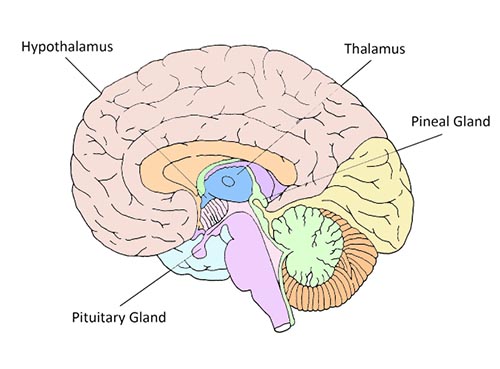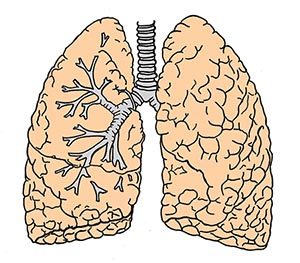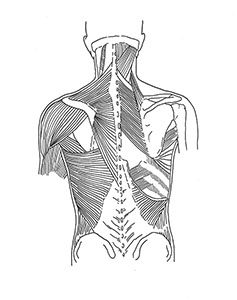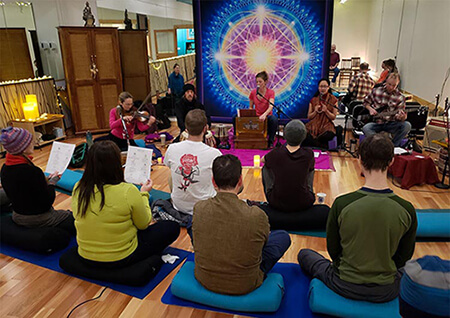
Exploring the Impact of Mantras
Explorations into the power of spiritual practices are clarifying the ways in which mantras affect the body, mind and spirit. In addition to the testimonials and personal experiences of yogis, monks, and lay people for thousands of years, mantras are now being scientifically studied. This article delves into many aspects of the impact of mantras on the brain, endocrine system, hearts and the consciousness of those who practice this ancient approach to enlightenment.
Share this page with a friend!
Watch nearly 400 videos on the Vocal Medicine Channel!
Impact of Mantras on the Brain
Sanskrit is called the “Mother Tongue” because it is the root source of many other languages. The sounds of Sanskrit are said to mimic the natural world. This is particularly true of the seed or bija syllables. These are single syllables that are purported to connect to fundamental forces in nature such as electricity, magnetism, fire, wind and so forth. To learn more about the bija syllables, explore the article One Word Mantras.
Vibration of Sanskrit Letters
Each letter of the Sanskrit language carries a specific vibration that unites the mind with pure sound. This is true of other languages as well, but has been thoroughly documented in the case of Sanskrit in ancient writings and the oral tradition. The sound of each vowel and consonant creates a bridge between the energetic and physical worlds.
Power of Sound
Sound stimulates the brain to regulate sleep patterns, decrease anxiety, and increase feel-good hormones. The use of mantras has many beneficial impacts on the brain. Some studies have specifically looked at the use of Sanskrit, the main language used in Eastern mantras. The positive impact on the brain for those learning mantras or reciting Sanskrit sacred texts is being referred to as the “Sanskrit effect.”
Why the Brain Loves to Sing
Scientists have determined five main reasons why your brain loves to sing:
- Sound stimulates the pituitary master endocrine gland
- Oxytocin is released to create positive social bonding
- Group singing releases dopamine, increasing feelings of well-being
- Singing vibrates the pineal gland, regulator of sleep patterns
- Group singing reduces stress chemicals including cortisol
Research and Neuroscience
James Hartzell, Ph.D., a neuroscientist researching the topic, has looked at the physical changes in the brain that happen during the memorization and recitation of Sanskrit texts. He discovered that Sanskrit pandits have over ten percent more grey matter across both cerebral hemispheres, a measurement consistent with higher cognitive functioning.
Expanding the Hippocampus
The right hippocampus, connected to long-term and short-term memory, is also sensitive to auditory and visual patterns. The hippocampus in the brains of Hartzell’s subjects was shown to have more grey matter across nearly seventy-five percent of its structure.
Impact of Mantras on the Pineal Gland
The pineal gland is known to produce melatonin, which helps to regulate sleep patterns. Scientifically speaking, the other functions of the pineal gland are not fully understood. From a mystical standpoint, entire books have been written about the pineal gland, which is said to be intimately connected to the third eye or Ajna chakra, an energy center in the forehead between the eyes.
Pineal Gland and Psychic Vision
The pineal gland is reputed to be the source of psychic vision or the “eye of God.” The pineal gland is discussed extensively in Manly P. Hall’s classic book Man: The Grand Symbol of the Mysteries. This gland “is regarded as a link between the objective and subjective states of consciousness; or, in exoteric terminology, the visible and invisible worlds of nature.”
Pineal Gland and Higher Consciousness
The importance of the pineal gland in the development of higher consciousness is emphasized in many traditions. Some view the pineal gland as a receptor for spiritual vibrations, sort of a radio station between the physical and the spiritual worlds. René Descartes, the French scientist and philosopher, believed that the pineal gland was the “seat of the human soul.”
How Does Group Singing Affect the Brain?
Group singing brings the individual into harmony with the group as well as the sound itself. There are physiological processes at the root of the sense of connectedness and social flow that happens in group singing and kirtan music. Oxytocin and dopamine (feel good chemicals) are both released, and cortisol (a stress chemical) is reduced.
Power of Oxytocin
Oxcytocin means “quick birth,” a reference to the first bonding experience in life between a mother and her infant. Oxytocin also has a broader role in mediating social and emotional behaviors. Professional musical performance can actually have a negative impact on the body chemistry of the performers. The stress of performing can increase levels of cortisol, a chemical associated with anxiety.
Reducing Cortisol Levels
In contrast with this, feel-good chemicals are released in kirtan music and other forms of group singing. This positive impact is present for both the leader and kirtan music participants. Singing in a group generally reduces levels of cortisol.
Releasing Endorphins
In addition, the sense of elation in group singing may come from the release of endorphins. Endorphins are associated with feelings of pleasure. For this reason, group singing has been studied as a successful antidote for depression.
Lorem ipsum dolor sit amet, consectetur adipiscing elit. Ut elit tellus, luctus nec ullamcorper mattis, pulvinar dapibus leo.
Connection Between Mantras and Languages
All languages have their own identity and characteristics. The emphasis on certain sounds creates a unique overall impact that can be recognized historically and energetically. Thus, French is considered to be a language of diplomacy and Italian has been viewed as the language of love. German has a grounding aspect and Spanish is a highly relational language.
English and Angelic Tongues
Some consider English to be a language descended from angelic tongues. Other liturgical languages like Latin, Hebrew, Greek and Gurmukhi have their own mystical and spiritual qualities. Sanskrit is the most prominent language used in mantras, however, every language has beneficial characteristics and effects.
Concrete Benefits of Mantras
Science is demonstrating that the ancient practice of mantra yoga has concrete benefits. The recitation of mantras is both a spiritual practice and a practical art. However, the effects of mantras are not restricted to the spiritual realm, but clearly also impact the brain and body in multiple positive ways.
Impact of Sanskrit Vowels on Mantras
Every sound literally vibrates the cells, bones, organs, and fluids in the body. The sonic power of vowels is recognized in many languages and systems. In the eastern tradition, Sanskrit vowels correspond with various bodily systems:
AH (A): assists with the health and strength of the lungs, energizes the mind
EE (E): positive effect on the throat and the brain, alleviates depression
AI (I): supports the health of the kidneys and urinary tract
OW (O): strengthens the functioning of the reproductive system
UH (U): supports a healthy heart and pumping of the blood throughout the body
Vowels and the Five Elements
The vowels can also be correlated with the five elements system utilized in feng shui and acupuncture as outlined below:
Vowels Sounds (Feminine Energy)
A (AA): spiritual opening, passion, anger, liver and gallbladder
E (EE): discernment, joy, disappointment, heart and small intestines
I (EYE): energy, concentration, will, brooding, spleen and pancreas
O (OH): mental activity, confidence, fear, kidneys and bladder
U (EW): potentiality, physicality, grief, lungs and large intestines
Consonants (Masculine Energy)
H: opening, totality of space
K: big bang, initiatory energy
L: soft parameters, restriction to a chosen location
M: appreciation, material world, Mother energy
N: closing, strong or sudden stop
S (V, Z): gathering energy all around
T (D,B): explosion of energy
Y: affirmative, desire, continuation, assent
(Vowel and consonant notes from a presentation by Bonnie Johnstone of Harmonic Embodiment at the Global Sound and Consciousness Institute Conference)
Consonants in Mantra Yoga
The power of the vowels can be harnessed by controlling and directing them with the energy of the masculine consonants. A few examples of the role of consonants in words include:
L: focuses energy in a chosen direction
M: appreciation, continues spiritual action
N: power, closing, very strong stopping point
S: all directions, gathering (also SH, V, Z)
T: explosion of energy (also D and B)
Y: desire, agreement
It is interesting to note that the consonant “n” is used in many languages to indicate disagreement or an attempt to stop someone else: No! (English), Nee! (Afrikans), Niet! (Russian), Nein! (German), Nahi! (Hindi), Non! (French), Nei! (Norwegian). And the consonant “y” is often used to indicate union or an understanding: Yes. Yah. Yay. Yoga. Ye.
RELATED RESOURCES
One Word Mantras
Sacred Sound Healing
Mantras & the Meridians
Mantra yoga stimulates the channels of energy in the body known as meridians. There are eighty-four meridians that end in the mouth. There are two meridians each for the thirty-two adult teeth in the hard palate and twenty additional meridians in the soft palate in the roof of the mouth.
Placement of the Tongue
The effect of mantras on meridians is related to the placement of the tongue in various positions to form words during speaking or chanting. This connects these meridians to the brain, increasing the energy flow to the pituitary, thalamus, hypothalamus and pineal glands.
Role of the Endocrine System
Each of these glands are important parts of the endocrine system. Moreover, they are purported in metaphysical and occult literature to have significant roles in the development of spiritual faculties.
Pituitary Gland
The pituitary gland produces hormones that help to regulate the functions of other endocrine glands. The pituitary gland rests in a bony hollow in the brain directly behind and a little below the bridge of the nose. The pituitary is often called the master gland because of its control of the thyroid and adrenals as well as the ovaries and testicles.
Thalamus Gland
The thalamus gland relays sensory information in the form of hormones from receptors in various parts of the body to the cerebral cortex. The hypothalamus affects temperature regulation, food intake, water intake, sleep and waking patterns, emotions and memory.

Impact of Mantras on Breathing Practices
The repetition of a mantra is closely aligned with breathing practices. This does not even have to be a conscious effort in order to experience the effects of mantras. The rhythmic nature of a repeated mantra naturally creates a cyclical pattern of breathing. Synchronizing through Sounds When people are singing or chanting together, studies have shown that their heart rates and breathing tend to synchronize. This helps to create a sense of connection and community on multiple levels. In addition, many spiritual traditions view the breath as the bridge between the inner world and the outer world. The Breath and Reality Controlling the breath or expanding the breath can change our perception of reality. Observing and adjusting the breath joins our minds and spirits to our bodies. The core of mantra yoga as well as other yoga practices is a direct experience of God. This creates a form of somatic spirituality or embodied spirituality versus an intellectual study or understanding of God.Air Quality in indoor Environments
On the physical level, something else to consider is the air quality in your indoor environment. Many of us in the modern world deal with toxins in the air. Diffusing essential oils is one way to help create a healthier environment for spiritual practices. Learn more about essential oils and the seven major chakras on this website at Chakras and Essential Oils.
Benefits of Essential Oils
Learn more about the benefits of essential oil diffusion on the Essential Drops of Joy website. Buy essential oils at discounted rates (24% off) with Kathleen Karlsen as your mentor (Brand Partner #1043288) at Young Living Essential Oils.
RELATED RESOURCES
Chakras and Organs
Chakras and Vowel Sounds
Chakras and Essential Oils

Impact of Mantras on the Body
There is also scientific evidence that using mantra yoga revitalizes the physical body. The relaxation response (lowered heart rate, lower blood pressure, slower breathing rate) is triggered by various forms of meditation and spiritual practices including mantra repetition.
Mantras and the Relaxation Response
The effect of mantras and the relaxation response has been well-documented by Herbert Benson, professor of medicine at Harvard Medical School. Benson recommends the use of a mental device (such as word, phrase or repeated activity) to keep the mind focused. This results in activating the parasympathetic nervous system for relaxation.
Mantras and the Tomatis Method
There is also a dramatic example of the use of chanting to replace many hours of sleep each night: In the late 60s, Alfred Tomatis, a French Physician and specialist in the function of the human ear, conducted an experiment with a Benedictine monastery where the monks were suffering from fatigue and depression.
Chanting Among the Monks
Tomatis discovered that a new decree had halted the usual six to eight hours of chanting the monks had previously observed and, within a short time, the monks were unable to perform their duties. When Tomatis suggested re-instituting their daily chanting, the monks recovered quickly and were able to resume their demanding schedule of work and prayers.
Chanting and the Bones
Tomatis concluded that chanting actually affects the bones of a human being, stimulated at about 2000 Hz. The sounds of chanting are produced literally from the bones, not the mouth.
Author Kathleen Karlsen
Kathleen Karlsen is a musician, artist, writer and speaker. She is the author of two books (Flower Symbols and Vocal Medicine) and over 200 articles. Kathleen, her husband Andrew, and their five children live in Bozeman, Montana. More about Kathleen Karlsen.
Article Summary
Lorem ipsum dolor sit amet, consectetur adipiscing elit. Ut elit tellus, luctus nec ullamcorper mattis, pulvinar dapibus leo.
Click for all content on our Site Map
Share this page with a friend!
Listen on Spotify!
Click to hear
108x Around the Heart
Click to hear
Vocal Medicine Kirtan







